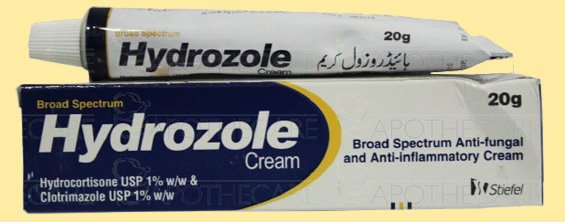- Hydrozole Cream contains
Hydrocortisone 1%
Clotrimazole 1%
What is Hydrozole Cream Used For?
Hydrozole is indicated for dermatophyte and yeast infections like fungal infected dermatitis, intertrigo and Candida nappy rash.
Hydrozole Dosage and Method of Administration
Adults, elderly, children and infants: Apply thinly and rub gently on the clean dry areas of affected skin twice a day to a maximum of 7 days under medical supervision. Care should be taken when using Hydrozole in elderly and children to ensure the amount applied is the minimum that provides therapeutic benefit.
Renal / Hepatic Impairment: The minimum quantity should be used for the shortest duration to achieve the desired clinical benefit.
When to avoid Hydrozole Cream?
Patients with known history of hypersensitivity to hydrocortisone, clotrimazole or any components of the Hydrozole Cream, primary cutaneous viral infections, primary infected skin lesions caused by infection with fungi or yeasts when inflammation is not prominent, primary or secondary infections due to bacteria, rosacea, acne vulgaris, pruritus without inflammation.
Hydrozole Drug Warnings and Precautions
- Manifestations of hypercortisolism (Cushing’s syndrome) and reversible hypothalamic-pituitary-adrenal (HPA) axis suppression can occur in some individuals as a result of increased systemic absorption of topical corticosteroids, that may occur due to potency and formulation of topical steroid, duration of exposure, application to a large surface area, use on occluded areas of skin e.g. on intertriginous areas or under occlusive dressings (like nappy in infants), increasing hydration of the stratum corneum, use on thin skin areas such as the face, use on broken skin or other conditions. In such cases, withdraw the drug gradually. Avoid abrupt withdrawal.
- Adrenal suppression can occur following long term treatment in infants and children under 12.
- The skin should be cleansed before a fresh dressing is applied.
- Extension of the infection may occur due to the masking effect of the steroid that requires withdrawal and administration of appropriate antimicrobial therapy.
- Prolonged application to the face is undesirable, as face is more susceptible to atrophic changes.
- If applied to the eyelids, it should not enter the eye, as cataracts and glaucoma might result.
- Topical corticosteroids are sometimes used to treat the dermatitis around chronic leg ulcers but are associated with a higher occurrence of local hypersensitivity reactions and an increased risk of local infection.
- If signs of hypersensitivity appear, application should be stopped.
- Hydrozole may cause damage to latex contraceptives when used together, reducing their effectiveness.
How Hydrozole Cream Interact with other drugs?
Co-administered drugs that can inhibit CYP3A4 (e.g. ritonavir, itraconazole) have been shown to inhibit the metabolism of corticosteroids leading to increased systemic exposure, depending on the dose and route of administration.
Hydrozole in Pregnancy and Lactation
Administration of Hydrozole Cream during pregnancy or lactation should only be considered if the expected benefit to the mother outweighs the risk to the fetus. Use minimum quantity for the minimum duration. Do not apply Hydrozole to the breasts to avoid accidental ingestion by the infant.
Possible Side Effects of Hydrozole Cream
Hypersensitivity, Hypothalamic-pituitary adrenal (HPA) axis suppression (including cushingoid features (e.g. moon face, central obesity), delayed weight gain/growth retardation in children, osteoporosis, glaucoma, hyperglycaemia, cataract, hypertension, increased weight, decreased endogenous cortisol levels, steroid withdrawal syndrome), allergic contact dermatitis, urticaria, skin atrophy, pigmentation changes, exacerbation of underlying symptoms, skin burning/skin pain, hypertrichosis, rash, pruritus, erythema, dry skin, stretch marks, blisters, skin exfoliation, irritation, skin edema and application site irritation/pain are very rarely reported in the post marketing data.
Hydrozole Overdose
In the case of chronic over-dosage or misuse, the features of hypercortisolism, dizziness, nausea and vomiting may occur. Gradually withdraw Hydrozole by reducing the frequency of application because of the risk of adrenal insufficiency.
Related Links

Leave A Comment